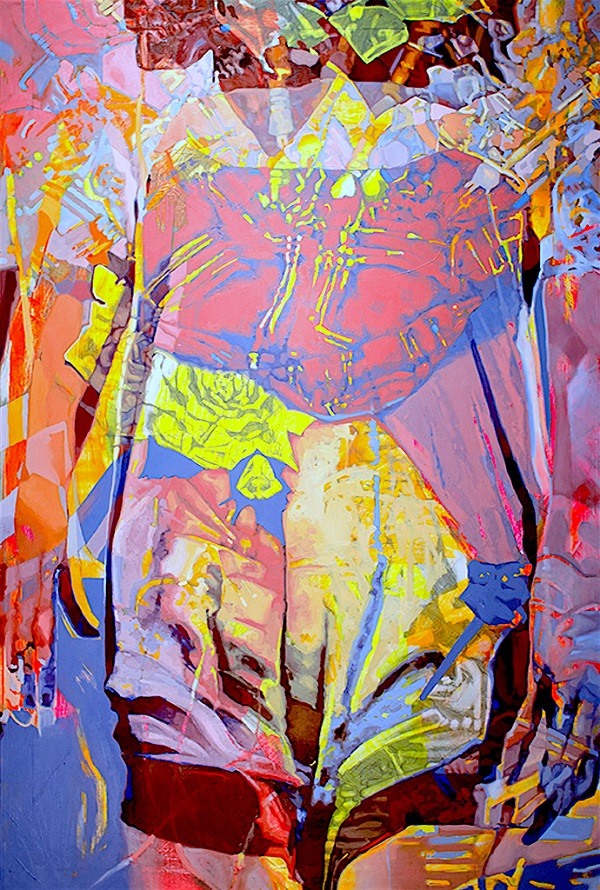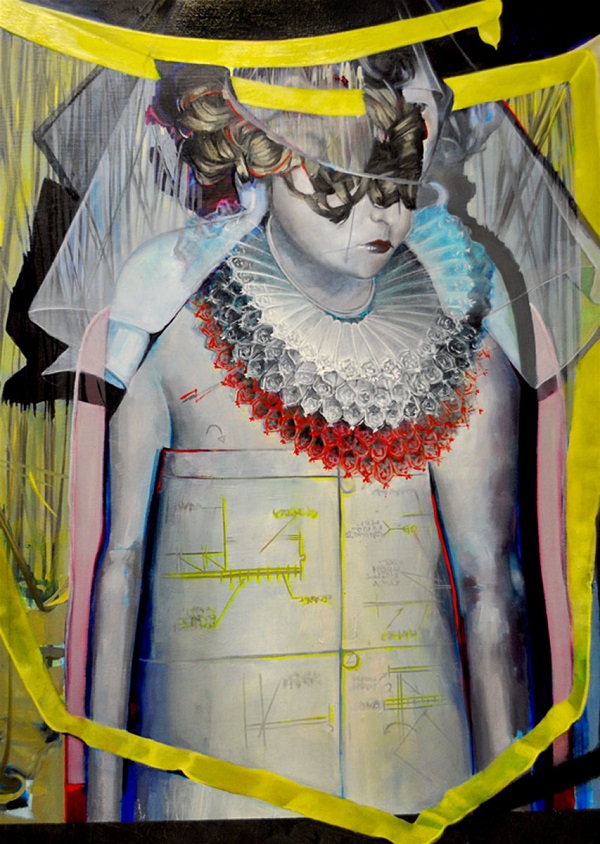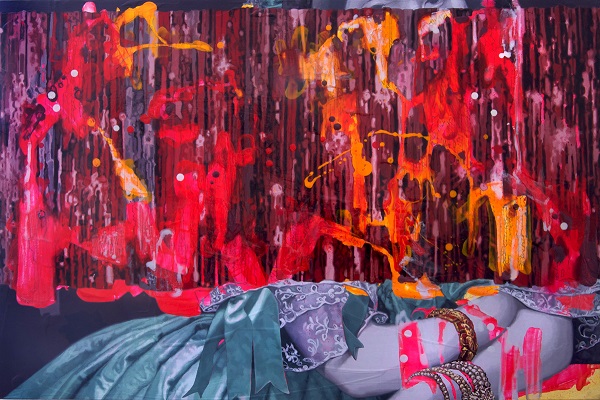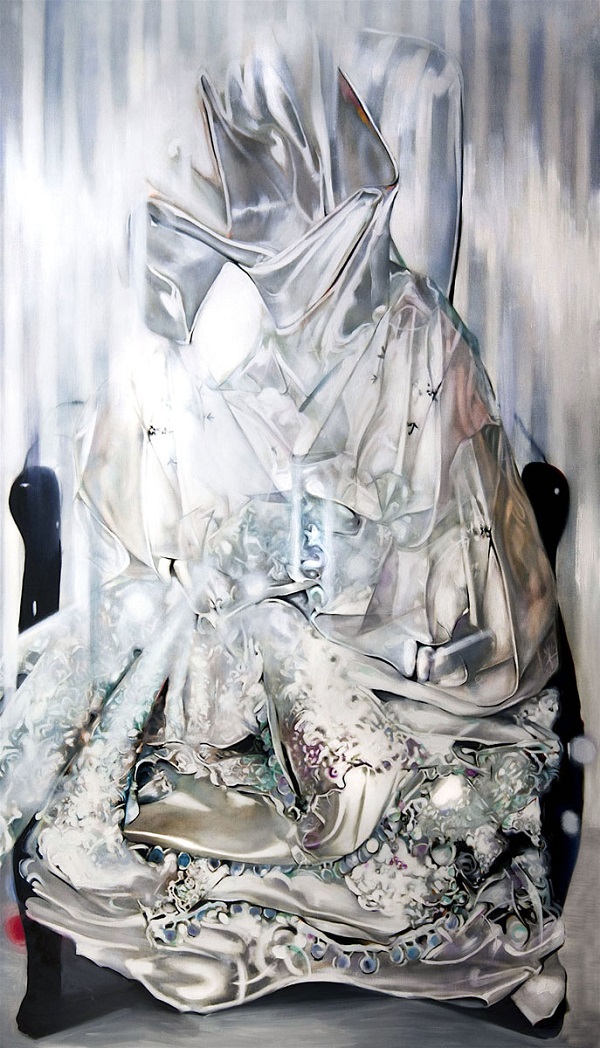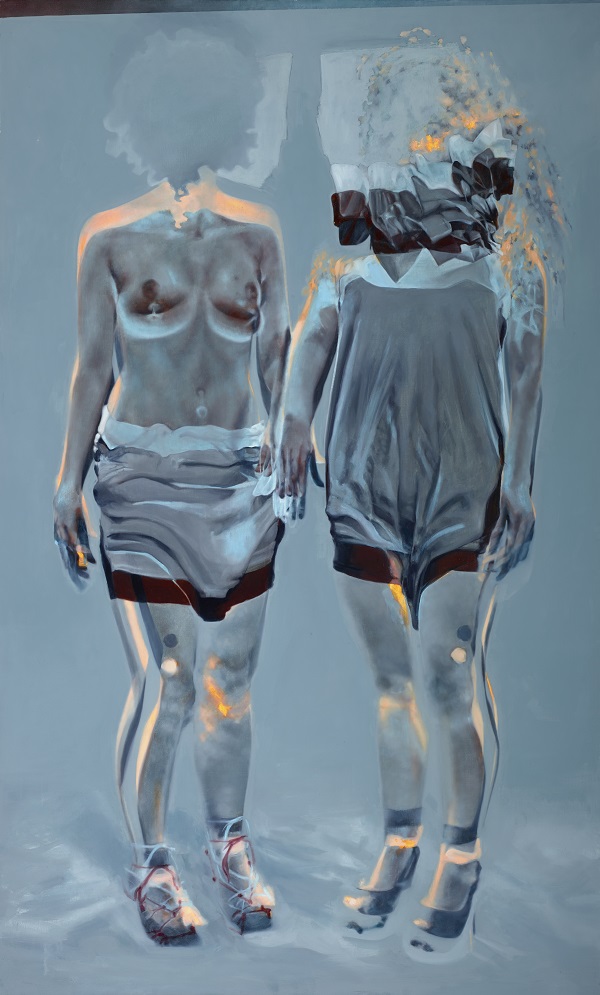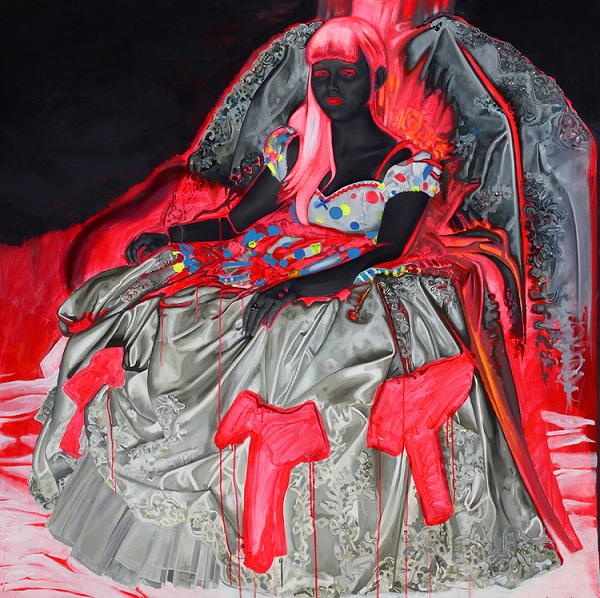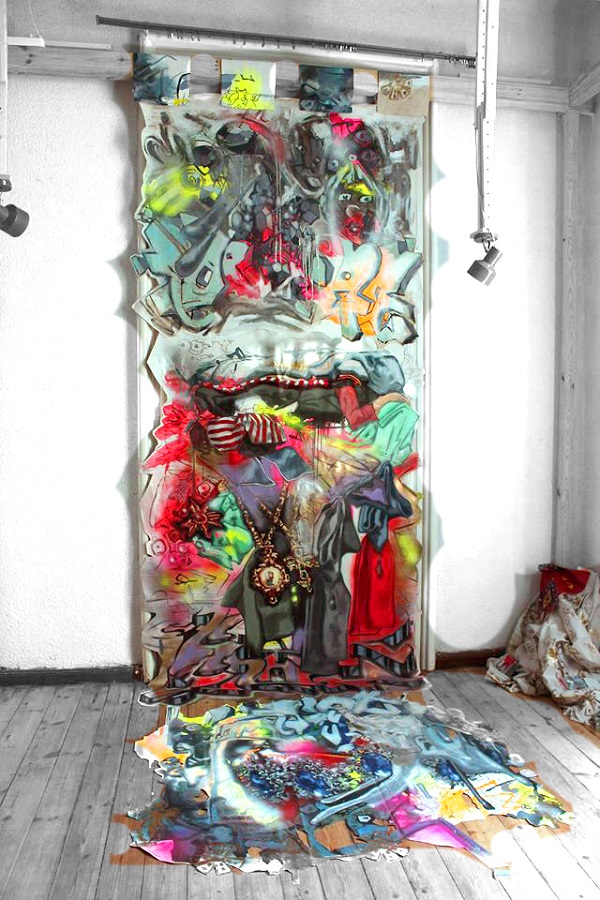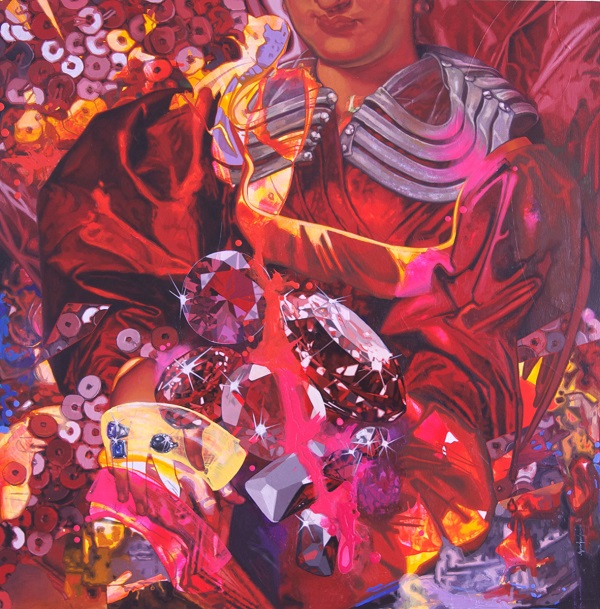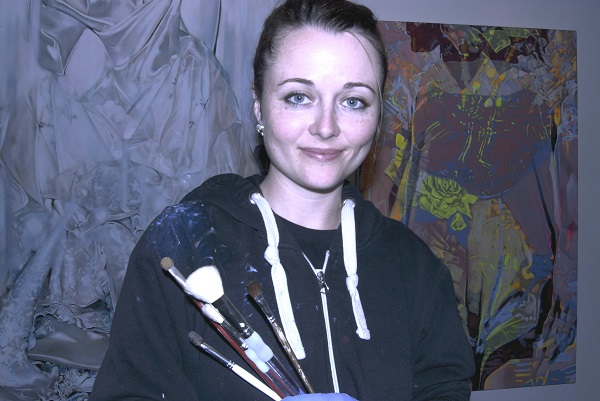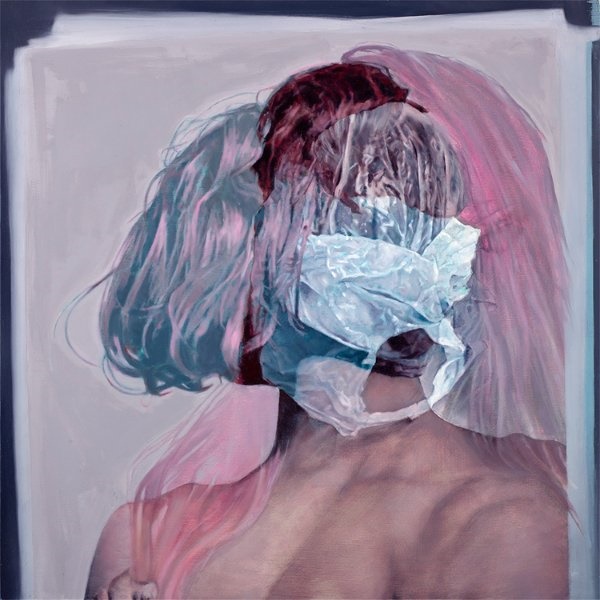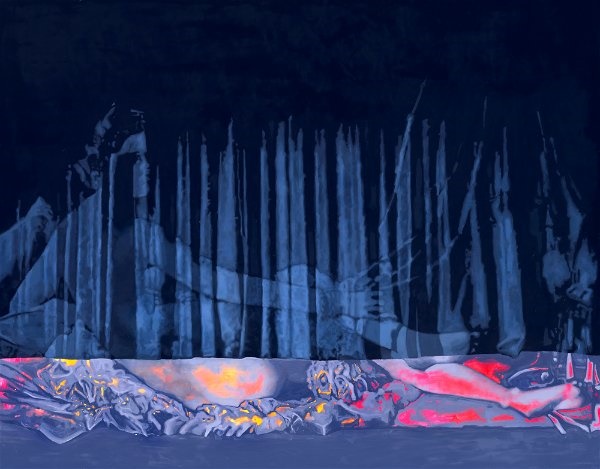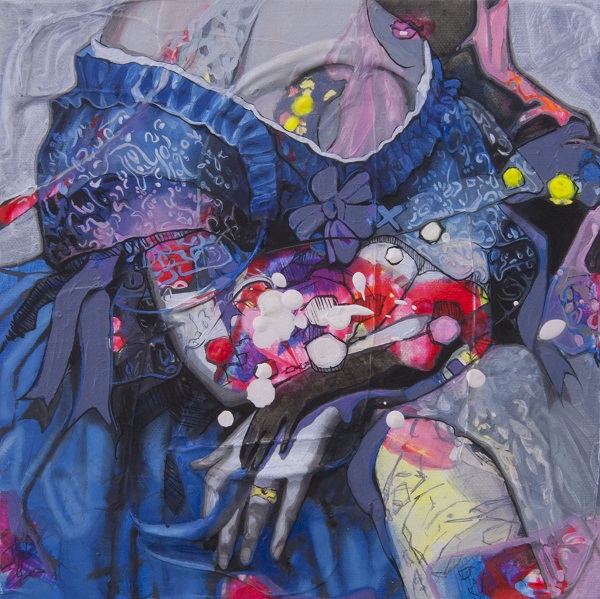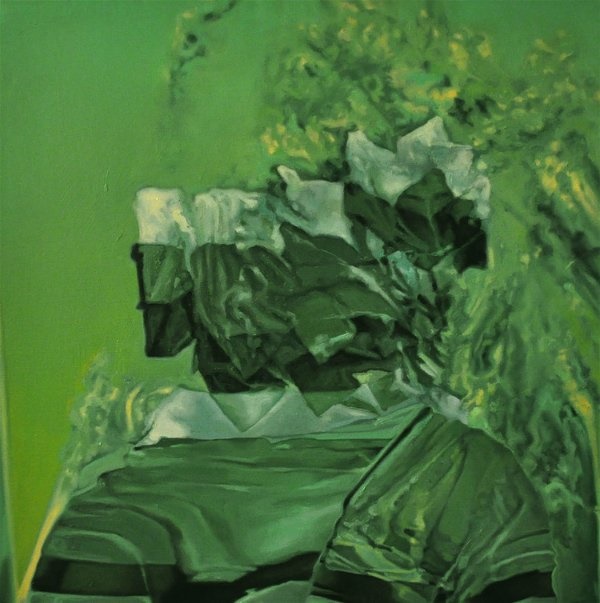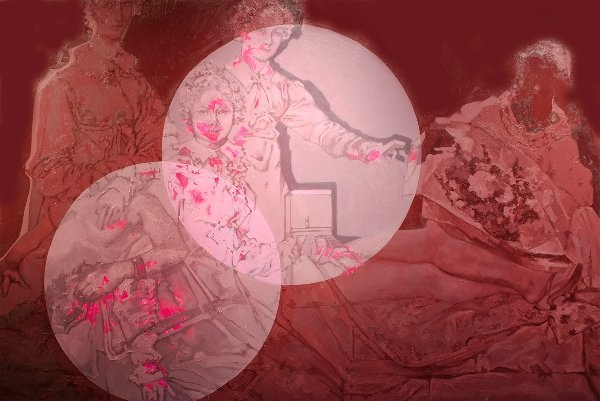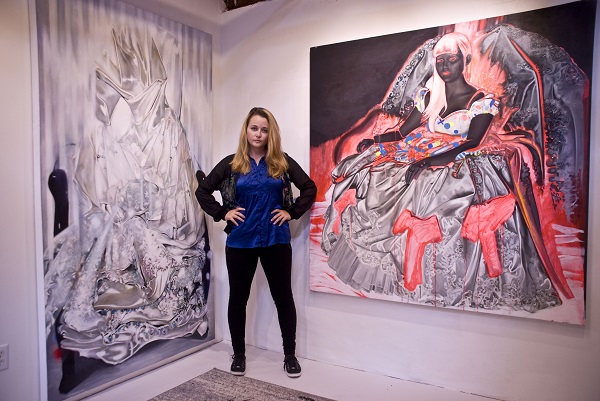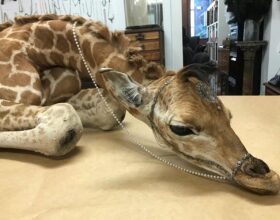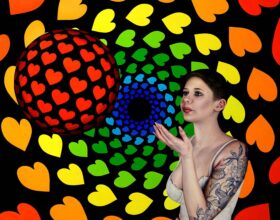Los Angeles-based painter, Zara Monet Feeney, is changing the way we look at figurative art. The artist, who received a BA from UCLA and an MFA from the Laguna College of Art and Design, sets aside traditional “passive” viewing in favor of an active perceptual experience. Zara’s dynamic works, which feature fragments of the female form, shift and alter the straightforward ways in which paintings are typically received.
“I exploit visual tools,” Zara says, “including negatives, highly saturated color notes, and diffused lighting adjacent to suffused lighting in order to create reflexive vision in the viewer.” The illusory experience created by Zara is both complex and colorful, and it is within this space that the puzzling prowess of her paintings deliver a chasmal spectrum of transparency, opacity, and all the splendor in between.
I spoke with Zara about her background, process, education, art collection, and more, in an exclusive interview. So read on and enjoy the rich visual feasts within. These tastes will shake awake your (once lazy) peepers.
Let me start with your background. When did you first begin to paint in your signature style, and what is it about that layered, vibrant depiction of altered perception that piques your interest?
There was not an exact moment but more of a slow process where I developed my style. This happened over the past ten years. I specifically love painting layers because when I make the work I am constantly finding strange color dynamics and new imagery within imagery. Ideally the viewer will engage longer with the piece and experience a personalized connection or unusual perception.
Were you always drawn to painting, or did you start out exploring other media? Do you still dabble in other media and materials, or do you keep mostly within your niche of oil painting?
I dabbled in painting as a kid but also worked in other mediums, sculpture, drawing, photography etc. When getting my bachelors at UCLA I was primarily interested in analogue photography for the first three years. It was not until my final year that I realized I was so interested in painting as a serious profession. Other mediums have been an important precursor to my current painting practice. Drawing has helped informed my ability to understand form and depth, sculpture has helped me create a varied textural surface and analogue photography has allowed me to see the most minute shifts in hue, saturation and value.
In order to achieve the effects you depict – namely your signature female forms among layers of gauzy and rumpled fabric – you must execute masterful painting techniques. How did you learn to achieve these layers — this transparency — with your paints, and how difficult is it to dance the line between the recognizable and the abstract?
It takes a lot of work to achieve these layers. I have to paint most areas very thick actually and pay extremely close attention to subtle color and value shifts as the form moves and bends. Everything makes a difference! Even how much pressure I use when I apply the paint, the control of my wrist when I lift up my brush… also the viscosity of the paint- how quickly it will glide over the canvas. My process demands a mastery of materials and technique.
Under these thickly painted forms I do have washes and under painting, which I like to show through. Over the thick paint I will often have transparent layers that gloss over…I like when different layers come through and others are covered. I love dancing between the line of recognizable and abstract, this comes naturally for me and is my favorite part of the painting process. I like to leave the recognizable forms unfinished so there is always room for them to melt into abstract forms or the void of empty space.
You grew up in Thousand Oaks, California, and your parents took you to museums and gave you the middle name Monet. Sooo, obviously one or both of them are supporters of the arts. Can you tell me a bit about your folks and about any other artistic relatives in your extended family?
My parents and my brother have been my main influence and inspiration to become an artist. They are always so encouraging and supportive. I owe everything to them. My dad is a photographer, my mom is a painter and sculptor and my brother is a painter. Growing up I was so lucky to be able to go to museums frequently, and to go to music and dance performances. My family has exceptional taste in art and truly appreciates quality work and talented people.
Let’s talk about your education. You received your M.F.A. from Laguna College of Art and Design in 2014. What were some of your most challenging classes there? Did you have a particular professor that you connected with in a special way, and do you still see or talk with this person?
I really enjoyed the plein-air painting class with Kenny Harris. He would bring the class to different outdoor locations and have us paint on-site with portable easels. This helped trained me to see the subtle color, light and value shifts that exist in nature that do not show up on a photograph. In seeing these minute differences in nature my eyes became hyper trained to see what was not there if I had to paint from a photograph.
I also really enjoyed the art theory class with Peter Frank. He would take us to different galleries and museums around Los Angeles and have us observe and critique different artists techniques and show layouts. This helped introduce me to the Los Angeles art scene.
Tell me a bit about your living space. Many artists have collections of original art in their homes, created by their artist friends or colleagues in their networks. Do you have an art collection of your own, and if you do, could you tell us a bit about it?
Growing up I was fortunate to have my parents and my brother’s artwork all around the house. This really shaped my appreciation for artwork and lots of different types of artwork. In the house I live in now, I display my friend’s work. Over the years I have been gifted or have made trades with my art friends. I love having artwork around me from people that I know! It really helps my creative process!
What music do you listen to when you cook and do dishes? What about while you are painting?
I love to cook and this is actually one of my favorite hobbies. I like to take a long time making complex and “from scratch” meals, and relax. While cooking I listen to jazz or Motown from the 50/60’s. When I paint, however, I cannot have the same relaxed feeling or I will end up just singing and dancing (or fall asleep!) instead of getting work done. Painting feels more like a job that I love than a relaxing hobby so I need to have high energy music with no lyrics so I do not get side tracked. I love instrumental hip-hop and minimal-style dub step. Anything with dramatic bass and unexpected musical patterns. A favorite band that comes to mind is Ratatat.
I have my family, of course, but I also have two cats that I chill out with when I am feeling creatively stuck, or generally “down in the dumps.” Do you have any pets, and do they fit into your creative process in some way?
I have an awesome cat named Phthalo, which I named because I am obsessed with that color.
I’m curious about your favorites. First off, what is your favorite museum in the LA area and why do you love it?
I love the Norton Simon museum. I like that it has a little bit smaller collection so you can be more intimate with the work. I am a particular fan of the paintings by Jean-Auguste-Dominique Ingres and Edouard Manet. I can learn so much about painting just by staring at these paintings closely and for a long time. I am obsessed with how they paint lace, jewelry, cloth etc.
Who are a couple of your favorite artists, and why do they stand out to you?
I appreciate all types of art from many different eras. A few favorites that come to mind are Jean-August-Dominique Ingres, Julie Mehretu and James Turrell. I love how Ingres paints candy like fabric, I love how Mehretu uses composition and drawing and I love Turrells mind-blowing light installations. All three types of work inspire me while I paint.
What are your favorite female subjects to paint and why are you drawn to that look?
I am drawn to powerful and dominating female subjects. Instead of a female form becoming an object for male gaze, I want to flip this idea so the female in the painting is looking at you—saying, I don’t even care about your male gaze.
I’d like to transition now into technique. You paint textures, creases, and folds so convincingly, so expertly. I see silk, plaid, taffeta, velvet…what fabric is your favorite to put into a painting, and why, and when did you get started working with fabrics as one of your primary compositional elements?
I think I started in my senior year of undergrad, at the same time I realized I wanted to become a professional painter. I think my love of fabrics started with my love of the stage, performing, and costumes. I started painting my old dance costumes and realized that I was obsessed with the shape and look of how fabric bends and dances with light.
I also love painting fabrics and also other visually interesting surfaces. I love surfaces that have candy-like qualities. I think it is my interest in optical illusion and how that becomes very pleasing to the eye!
I love the challenge of being able to mimic different types of surfaces, from matte black velvet to a high chrome metal – I love being able to control the dramatic or subtle light and color shifts. It is like an invigorating puzzle for me!
Artists are nearly always asked this question, but here goes anyway: how long, on average, does it take for you to complete one of your larger (approx 70″ x 40″) paintings? I can image there is a fair amount of waiting for layers to dry before being able to work over certain areas.
Every painting can take a different amount of time. It all depends on how detailed or difficult the imagery I am painting. It also matters how motivated I feel. Sometimes I am bored with something and I drag it out for a few months, other times I get an extreme surge of energy or creativity (usually right before a deadline) and I can paint a huge complicated painting in 3 or 4 days. I actually work best under pressure when I feel like I have no choice but to work — it’s do or die!
I am curious about lighting. Do you ever use black light when you are in the process of working a new painting? Are your completed works ever lit using black light or any other unique forms of illumination?
Yes! I do like to change the lighting when I work. I like when a painting can work in warm, cool, black, synthetic or natural light. I like different parts of the painting to show up in a new way depending on the lighting
Sometimes I use black light in the galleries to light my work. Other times I like the paintings to look like that have black light on them but them are just lit with normal lighting. To achieve this I have to be very masterful in recreating this type of lighting within the technique of the painting itself.
Tell us a bit about your paint application process.
I stretch the cloth around the frame and then I do have a pretty particular process. I have neon colors, initially, and I want those to show through. So at first I put down really thick layers of white paint, and kind of make it sculptural, and if you look closer at the paintings they kind of have gauzy masses coming out. I want to have something that has an interesting surface right away, and then everything built on top of that, hopefully will get more and more interesting.
You have an exhibition on view now at Moorpark College in Moorpark, California, correct?
Yes, my exhibition is titled, “Pause,” and it is on view until February 25, 2019.
Keep your watchful eyes on Zara on Facebook, Instagram, and on her website.


